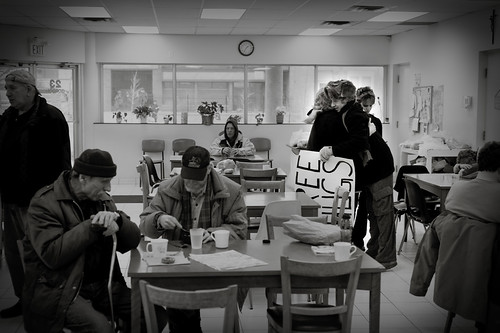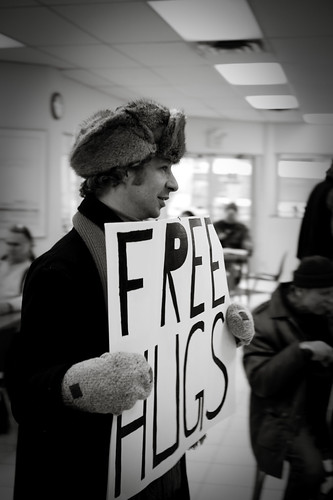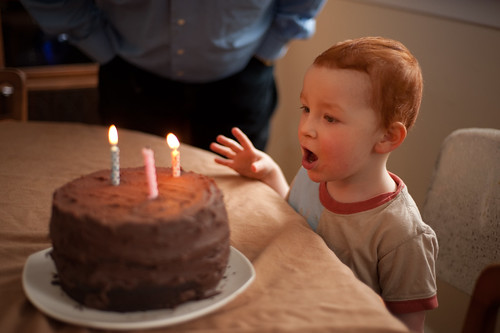I think I’m a little bit in love with South African photographer Mikhael Subotzky. I first discovered his work a few months ago, via JM Colberg. I was immediately drawn in by how he taught photography to the prisoners he photographed and got their work exhibited as well as his own. And of course, anyone who knows me knows I have a thing for South Africa and its people (my husband is South African too and almost all his family is still there). Subotzky reminds me of my husband’s cousins, who are smart and articulate and so much more engaged in the world around them than the young people I meet here in Canada. For all the country’s problems (and yes there are many and they are big), I think there’s something amazing going on there, culturally.
Anyways, Colberg published an interview with Subotzky the other day, and it made me fall a little bit in love. Every word of his responses made me think. In particular, I liked how he responded to Colberg’s question here:
“JC: I don’t know whether one would have the same impression living in South Africa, but looking from the outside – and from far away – it seems like South Africa had such a bright moment of hope when apartheid was dismantled and when Nelson Mandela was elected President, and so much has gone wrong since then, for whatever reason. Do you see it as your responsibility (if that’s a word you’d be comfortable with) to record what’s going on? To preserve this moment in time, maybe to foster some awareness and change?
MS: I am not sure if I believe that photographers can effectively take responsibility for such things. I do believe in the power of bearing witness, but I see it more as responsibility to ourselves – that we each have a responsibility to try and make ourselves as conscious as possible. Looking at the world around me through photography has become my way of doing that. While I am very happy that I can share images with others and try and show them things that they haven’t taken in, that isn’t the primary motivation for doing what I do.”
And later: “I think it is great to show people things they choose or are conditioned to ignore, and I admire those who can effectively do that. But I do have a real problem with the assumption that photographers can change the world by telling these “truths”. Some photographers have precipitated amazing change with their images. But it cannot be assumed – especially when the medium for this “preaching” is the traditional western media. As for me, I want to do many things with my work… sometimes I do want to try and show people things that they ignore, sometimes I do want to make a political point, but sometimes I also just want to express myself and try and qualify my experiences.”
* * *
My husband’s granny, my son’s only living great-grandparent, is in a hospital in Cape Town, and the prognosis isn’t good. I’ve had the good fortune to meet her twice, both times with the awareness that it could be the last time, and yet her voice is so strong and her eyes so clear, that part of me didn’t really believe it. I wish we could be there, especially since her recent hearing loss has made a phone conversation with her virtually impossible.
* * *
The other night, I discovered Katharina Bosse’s “Portrait of the Artist as a Young Mother” series (also through JM Colberg). I find her work really interesting, and as I’ve already written here, I’m particularly interested in explorations of motherhood. Apparently, a professor of photojournalism dismissed her work in a German publication as “irrelevant and a calculated provocation” (Colberg’s translation — I can’t speak or read German so I trust his representation). I find that statement pretty telling: motherhood is irrelevant – and yet highly prescribed – in the western world, and any attempt at making that experience central or subverting those presciptions is a calculated provocation.
Being a mother myself, Bosse’s images don’t really trouble me, but I can see how they might trouble people who aren’t mothers. Motherhood is such a physical experience, and I think our culture has a deep discomfort with and resistance to acknowledging that physicality. That is what her photos made me think about, that physicality, and this morning, when I went back to her site to link to it here, I noticed her artist statement, which I love (especially since it says pretty much the same thing but much more eloquently):
“After living in New York for six years, I moved to Germany and became pregnant. Nothing in my career as a photographer and artist had prepared me for this experience. Not only were the physical demands of carrying and caring for the babies demanding. It was a forced change from everything I had learned so far: individuality, ambition and workaholism. I felt like a teenager again, changing rapidly into a new person, not knowing the outcome. I started to look for articles, and images about this process and found lots of advice, but very few actual descriptions of the unsettling shift in identity I was experiencing. And so, over the course of four years, I brought to life two children and eight photographs. I felt compelled to undress (or dress up) and create images of motherhood I had not seen before. I gave up control of the shutter release, and got in front of the camera to extract a knowledge only my body could tell.”
* * *
Now here’s where I came to a dilemna. I discovered that another body of Bosse’s work is very similar to a project I’ve just begun (which I’m not ready to blog about yet). I only glanced at a few photos of that other series before I decided not to look any more. If I end up doing the same kind of project, at least I could say I hadn’t seen her work or been influenced by it. But I’ve always felt strongly that influence is good. I remember when I wrote poems in university, getting royally irritated on more than one occasion when people declared themselves poets (there goes that noun thing again), and in the same breath announced that they never read anyone else’s poetry, lest they be influenced. I still think that’s crap. The only way to be good at something is to be influenced by practitioners who are better than you. So I think I just have to see this as the opportunity it is and dive in.


